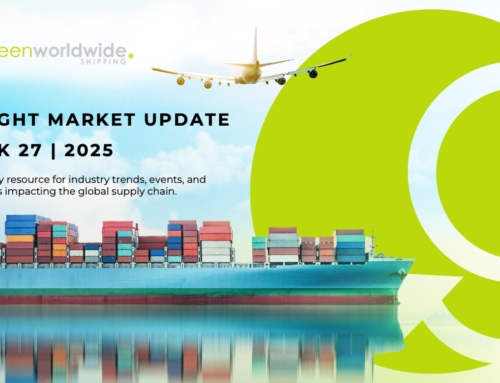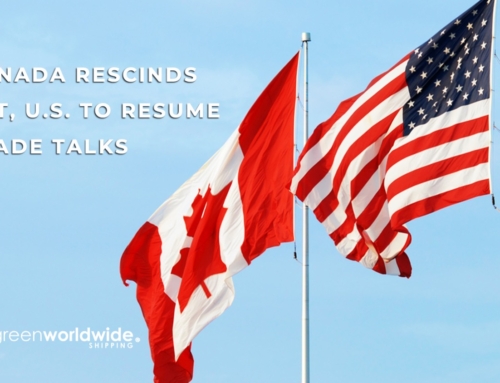As reported in early February, the outbreak and continuity of the Coronavirus (COVID-19) has created unprecedented strain on shipping and travel relationships between China and the rest of the world. Most notably, air and ocean freight carriers are experiencing a sharp decrease in activity, as shippers relying on Chinese-sourced goods struggle to maintain inventory.
OCEAN CARGO
It is projected that COVID-19 will ultimately cause the rate and volume of shipments to dwindle down in the first quarter of the year. Although it is difficult to predict the overall impact, shippers believe that container volumes are not likely to rebound until late in the second quarter of 2020.
Amidst the effects of COVID-19, Chinese New Year in late January also created an annual lull in shipments and exports. While lower numbers are to be expected during this holiday, Maersk, one of the largest steamship lines in the world, reported that it had cancelled at least 50 sailings more than is standard during the Lunar New Year.
Furthermore, reports have been made by European ports that nearly half of the shipments expected from Asia in the last month have been blanked. The Rotterdam Port Authority projects that the Coronavirus could cause a 1% loss of its annual volume. Although it may not seem like much—through the lens of last year’s volume, that could mean up to an 148,000 TEU deficit.
What all of this means for China’s ocean freight is that cargo volume at Chinese ports could see a TEU loss of more than 6 million containers in the first quarter of this year. China’s airfreight is also experiencing devastating impact from the blowback of the Coronavirus.
AIRFREIGHT
China’s air cargo market has fallen from 3rd largest in the world down to only the 25th since the start of Coronavirus and airlines have been vocal about the financial impact that COVID-19 has created. Major carriers have canceled most flights in and out of mainland China, while some couriers are still taking mitigated risks and servicing the area with caution. Beyond airfreight, commercial travel to Asia (especially China) has dwindled so much over the last few weeks that the Coronavirus could reduce Air France’s earnings by as much as €150-200 million this year.
MANUFACTURING & ECONOMY
Manufacturing has also decreased exponentially in China, as many factories and even highways have been closed. It is expected to slowly start recovering over the next few weeks, and eventually to ramp up to a higher pace than is standard in order to compensate for this extreme drop in shipping and manufacturing.
While concrete inventory is not being produced or moved at a normal rate, China’s economy has remained afloat. The Central Bank, along with other Chinese banks, have extended lines of credit and favorable bank loans in order to bolster the Chinese stock market and prevent a severe economic recession.
It is expected that China’s manufacturing and shipping should slowly start to recover in the next few weeks, and its economy should have maintained its levels despite the effects of the Coronavirus. The infection rate is decreasing, which should create an avenue for manufacturing to return to typical levels and imports/exports to start moving more freely once again.
CHINA PORTS
Port Congestion/Port Operation
- The loading/discharging operation has slowed down due to lack of stevedores.
- The land transportation of cargo to/from ports is insufficient since trucks without local license are prohibited from the port area.
- As vessels are restricted to call at Wuhan port, transshipment of cargo by inland river feeder vessels in/out of ports in the Yangtze River have been affected.
Ports affected: Shanghai, Tianjin, Huanghua, Lianyungang, Jingtang and Caofeidian
Ports not affected: Zhangjiagang and ports near Yangtze River have been congested due to heavy fog, rather than Coronavirus
USA PORTS
On January 31, 2020, the President of the United States issued a proclamation on the Suspension of Entry as Immigrants and Non-immigrants as persons who pose a risk of transmitting 2019 Coronavirus. This proclamation includes temporary suspension of foreign nationals (with some exceptions such as vessel crewmembers) who were physically present in the People’s Republic of China (excluding Hong Kong and Macau), during the 14-day period preceding their entry or attempted entry into the United States, to enter in effect February 2, 2020 at 5:00 pm Eastern Standard Time.
Vessel owners/operators and local stakeholders should be aware of the following:
- Any vessel carrying passengers that have been to China (excluding Hong Kong and Macau) will be denied entry into the United States. If all passengers exceed 14 days since being in China (excluding Hong Kong and Macau) and are symptom free, the vessel will be permitted to enter the United States to conduct normal operations. These temporary measures are in place to safeguard the American public.
- Non-passenger commercial vessels that have been to China (excluding Hong Kong and Macau) or embarked crewmembers who have been in China (excluding Hong Kong and Macau) within the last 14 days, with no sick crewmembers, will be permitted to enter the U.S. and conduct normal operations, with restrictions. Crewmembers on these vessels will be required under COTP authority to remain aboard the vessel except to conduct specific activities directly related to vessel cargo or provisioning operations.
- The Coast Guard considers it a hazardous condition under 33 CFR 160.216 if a crewmember who was in China (excluding Hong Kong and Macau) within the past 14 days is brought onboard the vessel during transit. This requires immediate notification to the nearest Coast Guard Captain of the Port.
- The Coast Guard will continue to review all “Notice of Arrivals” in accordance with current policies and will communicate any concerns stemming from sick or deceased crew or passengers to their Coast Guard chain of command and the cognizant CDC quarantine station, who will coordinate with local health authorities.
- Vessel masters shall inform Coast Guard boarding teams of any ill crewmembers on their vessel prior to embarking the team and Boarding Teams should verify the type of illnesses with CDC if concerns arise.
- Local industry stakeholders, in partnership with their Coast Guard Captain of the Port, should review and be familiar with section 5310 Procedures for Vessel Quarantine and Isolation, and Section 5320 – Procedures for Security Segregation of Vessels in their Area Maritime Security Plan.
- Local industry stakeholders, in partnership with their Coast Guard COTP, should review and be familiar with their Marine Transportation System Recovery Plan.
- For situational updates, please check with the CDC.
As Green continues to monitor the situation, stay up-to-date on freight news by following us on Facebook, Twitter, and LinkedIn. For continuous updates, make sure to check out our website at greenworldwide.com.






